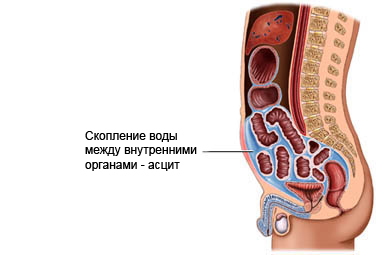Ascites
Description of ascites
Ascites – accumulation of excess fluid in the abdominal cavity. This disease is successfully treated, Therefore, for suspected ascites, you must consult your doctor.

Causes of ascites
Ascites, as rule, occurs when the liver diseases, including:
- Cirrhosis of the liver – disease, in which the liver becomes damaged and dies;
- Chronic hepatitis – infection of the liver;
- Severe alcoholic hepatitis without liver cirrhosis;
- Obstruction of the hepatic veins (blood vessels of the liver).
The cause of ascites may also be:
- Cancer;
- Heart failure;
- Renal failure;
- Pancreatitis;
- Tuberculosis.
Risk factors
Factors, that increase the likelihood of ascites:
- Alcoholism;
- Hepatitis b and c.
Symptoms of ascites
These symptoms may be caused by other serious diseases. When they occur, seek medical advice.
- Increased abdominal circumference;
- Breathlessness;
- Abdominal pain and/or bloating it;
- Pain in the side of the abdomen;
- Rapid weight gain;
- Shortness of breath while in supine position;
- Decreased appetite;
- Heartburn.
Diagnosis of ascites
The doctor asks about the symptoms, and medical history, and performs a physical exam. Tests may include the following:
- Ultrasound examination – test, which uses sound waves to examine the abdominal cavity;
- CT scan – such as X-ray examination, wherein the computer is used, to make pictures of structures inside the abdominal cavity;
- MRI scan – test, which uses magnetic waves, to take pictures of structures inside the abdominal cavity;
- Laparoscopy – a thin tube is injected through a small incision in the abdominal cavity, to explore the structure inside it;
- Blood tests, to define the functions of liver and kidney, as well as finding evidence of other problems, that can lead to ascitu;
- Biopsy roasted – selection of the sample of liver tissue for testing;
- Angiography – after the introduction of a radiopaque dye into the artery is performed X-ray of the blood vessel;
- Abdominal paracentesis – selection and analysis of fluid from the abdominal cavity.
Treatment of ascites
Treatment options include the following:
Changes in diet
- Limit salt intake to 2000 mg per day or less often recommend to reduce or delay the accumulation of fluid. A stronger limitation of salt intake is not conducive to improving the results;
- Ascites generally occurs in people with liver disease. Alcohol consumption might further worsen liver function. Stop drinking alcohol may limit the progression of ascites.
Diuretic (diuretic pills)
Diuretics – medicines, which stimulate the kidneys to excrete more sodium and water from urine. These drugs are often recommended for the treatment of ascites, along with the restriction of sodium intake.
Examples of diuretics:
- Spironolactone (Aldakton);
- Furosemid (LASIX);
Paracentesis
Ascites can be treated by injection of hollow needle into the abdomen and remove excess fluid through a needle.
Surgery
If other treatments are not effective and relapses ascites continues, can be operated, to withdraw blood from the liver.
Prevention of ascites
To reduce the risk of ascites, steps must be taken, to prevent liver cirrhosis – the most frequent cause of ascites:
- Drink alcohol in moderation. It means, no more than 40 grams per day for women and fifty-sixty for men;
- You must practice safe sex, to avoid hepatitis;
- When injections use disposable needles;
- Need to get vaccinated against hepatitis b;
- When taking medicine, which can damage the liver, You should follow the doctor's recommendation.
To prevent the recurrence of ascites, necessary:
- Do not drink alcohol;
- Limit the use of drugs, including non-prescription remedies (If they are not recommended another doctor);
- Limit your sodium intake;
- Take diuretics as recommended by your doctor.
